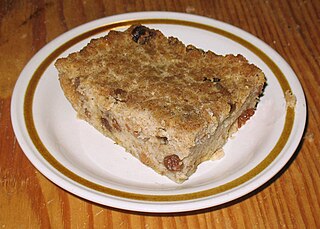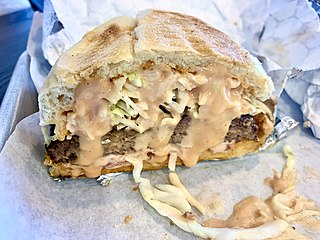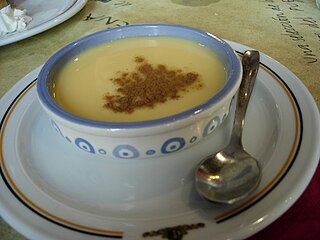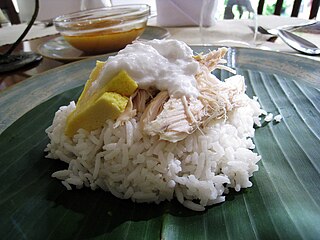
Blancmange is a sweet dessert popular throughout Europe commonly made with milk or cream and sugar thickened with rice flour, gelatin, corn starch, or Irish moss, and often flavoured with almonds.

Bread pudding is a bread-based dessert popular in many countries' cuisines. It is made with stale bread and milk or cream, generally containing eggs, a form of fat such as oil, butter or suet and, depending on whether the pudding is sweet or savory, a variety of other ingredients. Sweet bread puddings may use sugar, syrup, honey, dried fruit, nuts, as well as spices such as cinnamon, nutmeg, mace, or vanilla. The bread is soaked in the liquids, mixed with the other ingredients, and baked.

Puerto Rican cuisine consists of the cooking style and traditional dishes original to Puerto Rico. It has been primarily influenced by the ancestors of the Puerto Rican people: the indigenous Taínos, Spanish colonizers, and sub-Saharan African slaves. As a territory of the United States, the culinary scene of Puerto Rico has also been moderately influenced by American cuisine.

Crème caramel, flan, caramel pudding, condensed milk pudding or caramel custard is a custard dessert with a layer of clear caramel sauce.

Rice pudding is a dish made from rice mixed with water or milk and other ingredients such as cinnamon, vanilla, and raisins.

Haupia is the Hawaiian name for a traditional coconut pudding found throughout Polynesia.

A buñuelo (Spanish:[buˈɲwelo], alternatively called boñuelo, bimuelo, birmuelo, bermuelo, bumuelo, burmuelo, or bonuelo, is a fried dough fritter found in Spain, Latin America, and other regions with a historical connection to Spaniards, including Southwest Europe, the Balkans, Anatolia, and other parts of Asia and North Africa. Buñuelos are traditionally prepared at Christmas. It will usually have a filling or a topping. In Mexican cuisine, it is often served with a syrup made with piloncillo.

Manjar blanco, also known as manjar de leche or simply manjar, is a term used in Spanish-speaking areas of the world in reference to a variety of milk-based delicacies. In Spain the term refers to blancmange, a European delicacy found in various parts of the continent as well as the United Kingdom. In the Americas it refers to a sweet, white spread or pastry filling made with milk. This term is sometimes used interchangeably with dulce de leche or cajeta in Latin America but these terms generally refer to delicacies prepared differently from those just described. Related dishes exist by other names in other regions, such as tembleque in Puerto Rico. In Portuguese-speaking countries the dish is known as manjar branco.

Tavukgöğsü is a Turkish milk pudding made with shredded chicken breast. It was a delicacy served to Ottoman sultans in the Topkapı Palace, and is now a well-known dish in Turkey.

Dominican cuisine is made up of Spanish, indigenous Taíno, Middle Eastern, African, Cuban, Puerto Rican and Haitian influences. The most recent influences in Dominican cuisine are from the British West Indies and China.

Natillas is a term in Spanish for a variety of custards and similar delicacies in the Spanish-speaking world. In Spain, this term refers to a custard dish made with milk and eggs, similar to other European creams as crème anglaise. In Colombia, the delicacy does not include eggs, and is called natilla.

Coconut rice is a dish prepared by cooking white rice in coconut milk or coconut flakes. As both the coconut and the rice-plant are commonly found in the tropics all around the world, coconut rice too is found in many cultures throughout the world, spanning across the equator from Southeast Asia, the Indian subcontinent, South America, Central America, West Africa, East Africa, the Caribbean and Oceania.
Coconut pudding may refer to
Manjar branco is a pure white Brazilian coconut pudding similar to blancmange. It is identical to the Puerto Rican tembleque. In Brazil manjar branco is made in a ring (Savarin) mold and is served with a sauce made of pitted prunes poached in port wine. Commercial mixes for manjar branco and tembleque are available in Brazil, the U.S., and in other Latin American countries.

Maja blanca is a Filipino dessert with a gelatin-like consistency made primarily from coconut milk. Also known as coconut pudding, it is usually served during fiestas and during the holidays, especially Christmas.
Sago with coconut milk is a Burmese and Thai dessert. The main components of this recipe are sago and coconut milk. The dish can be decorated with many toppings; including taro, sweet potato, coconut, yellow corn, banana, and others. It is similar to various forms of Vietnamese chè.

Tibok-tibok or carabao-milk pudding is a Pampangan dessert pudding made primarily from carabao milk and ground soaked glutinous rice (galapong). Originating in the Philippine province of Pampanga, it is especially popular in Cagayan. It has a soft jelly-like texture and is topped with latik before serving. It is characteristically creamy white in color and has a delicate, sweet and slightly salty flavor. It is very similar to the more common maja blanca, albeit the latter is made with coconut milk and cornstarch.














